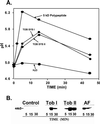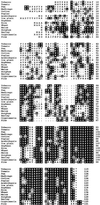RALF, a 5-kDa ubiquitous polypeptide in plants, arrests root growth and development
- PMID: 11675511
- PMCID: PMC60141
- DOI: 10.1073/pnas.201416998
RALF, a 5-kDa ubiquitous polypeptide in plants, arrests root growth and development
Erratum in
- Proc Natl Acad Sci U S A 2001 Dec 18;98(26):15394
Abstract
A 5-kDa polypeptide was isolated from tobacco leaves that induced a rapid alkalinization of the culture medium of tobacco suspension-cultured cells and a concomitant activation of an intracellular mitogen-activated protein kinase. An N-terminal sequence was obtained, and a cDNA coding for the 49-aa polypeptide was isolated from a tobacco cDNA library. The cDNA encoded a preproprotein of 115 amino acids that contained the polypeptide at its C terminus. A search among known expressed sequence tags revealed that genes encoding Rapid ALkalinization Factor (RALF) preproproteins were present in various tissues and organs from 16 species of plants representing 9 families. A tomato homolog of the polypeptide was synthesized and, when supplied to germinating tomato and Arabidopsis seeds, it caused an arrest of root growth and development. Although its specific role in growth has not been established, the polypeptide joins the ranks of the increasing number of polypeptide hormones that are known to regulate plant stress, growth, and development.
Figures






Comment in
-
Peptide signaling in plants.Proc Natl Acad Sci U S A. 2001 Nov 6;98(23):12855-6. doi: 10.1073/pnas.231490798. Proc Natl Acad Sci U S A. 2001. PMID: 11698672 Free PMC article. No abstract available.
References
-
- Pearce G, Moura D S, Stratmann J, Ryan C A. Nature (London) 2001;411:817–820. - PubMed
-
- Felix G, Boller T. Plant J. 1995;7:381–389.
Publication types
MeSH terms
Substances
LinkOut - more resources
Full Text Sources
Other Literature Sources
Molecular Biology Databases

